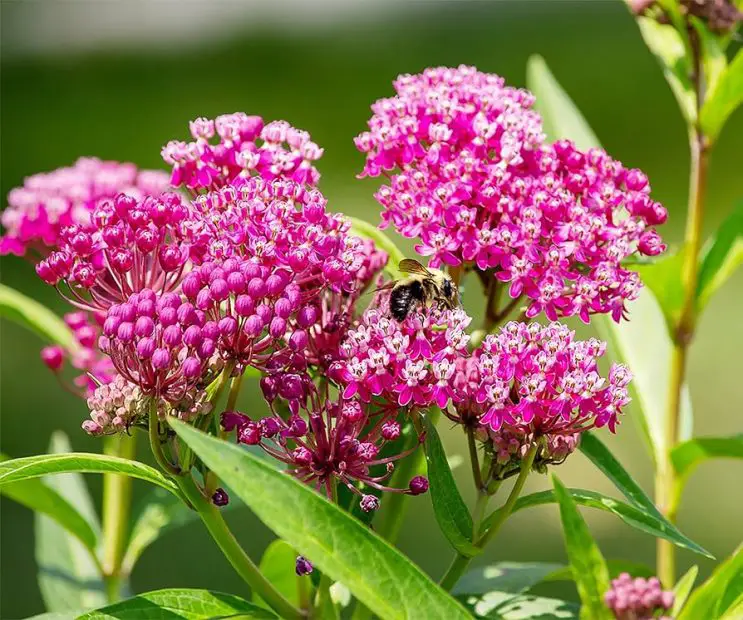Milkweed, long celebrated for its role in supporting monarch butterflies, has also stirred legal concerns in several U.S. states. While many gardeners plant milkweed as a way to help pollinators, some jurisdictions have placed restrictions or outright bans on specific species. This contradiction often confuses gardeners who are eager to support native ecosystems but don’t want to violate local laws.
The reason behind these laws varies. In some regions, certain milkweed species are considered invasive or potentially harmful to livestock. In others, outdated laws remain on the books, unintentionally discouraging the cultivation of native plants that are critical to wildlife.
The Legal Status of Milkweed Across the U.S

Milkweed’s legal status varies significantly from state to state, often depending on how local governments interpret its ecological impact versus its historical reputation as an agricultural weed. While most gardeners in the U.S. can grow milkweed without issue, there are exceptions where certain species are still legally restricted or discouraged.
States Where Milkweed Is Labeled as a Noxious Weed
In a handful of U.S. states—such as Iowa, Ohio, and Minnesota—common milkweed (Asclepias syriaca) is listed as a noxious weed under older agricultural statutes. These classifications were originally introduced when large-scale farming operations saw milkweed as a threat to pastureland and crops, primarily because of its aggressive underground rhizome spread and minor toxicity to livestock.
In Iowa, for instance, Asclepias syriaca has been included in the noxious weed list since the mid-20th century. While enforcement is minimal today, the law still technically allows local authorities to demand removal in certain agricultural or roadside zones. Similarly, in Ohio, milkweed is regulated in some counties, particularly when growing unchecked near croplands.
However, these laws do not generally apply to ornamental or residential gardens, and enforcement is rarely directed at homeowners planting milkweed for ecological purposes.
Changing Legal Perspectives in Other Regions
Some states are actively revising or relaxing previous bans due to increased awareness of milkweed’s role in monarch conservation. For example, Minnesota—once known for strict regulation—now encourages planting milkweed in pollinator corridors and public landscapes. New York and California have also launched large-scale milkweed distribution efforts to support monarch recovery.
This growing movement is supported by conservation organizations, botanical institutions, and even the U.S. Fish and Wildlife Service, which has funded native milkweed planting as part of its monarch butterfly recovery plan.
The Role of Tropical Milkweed in Legal Confusion
Tropical milkweed (Asclepias curassavica) is one of the most widely available milkweed species sold in nurseries across the U.S.—but it’s also one of the main sources of legal and ecological confusion. Native to Central and South America, this species thrives in warm climates and does not die back in winter like native milkweeds. That seemingly small difference has led to major conservation concerns.
In regions like the southern U.S., where tropical milkweed can grow year-round, it disrupts the natural migratory patterns of monarch butterflies. Instead of continuing their journey to overwintering sites, some monarchs linger in areas with constant food availability. This behavior increases their exposure to parasites, particularly Ophryocystis elektroscirrha (OE), which can spread more easily on plants that remain in bloom year-round.
This ecological issue has contributed to misunderstandings in regulation. When officials or land managers observe problematic outcomes linked to tropical milkweed, they sometimes issue blanket restrictions on “milkweed” in general, without distinguishing between harmful non-native species and beneficial native ones. The result is confusion among gardeners, inconsistent enforcement, and the unintentional discouragement of conservation planting.
Clearer communication about tropical vs. native milkweed is crucial. Scientists and conservation groups now recommend either avoiding tropical milkweed altogether or cutting it back each fall to mimic natural dieback and reduce disease risks. At the same time, they encourage the use of regionally native milkweeds that better support monarch life cycles and comply with most local regulations.
In short, tropical milkweed’s unique characteristics have unintentionally muddied the legal waters, making it essential for both policymakers and the public to understand the differences—and make informed, ecologically responsible choices.
Urban Gardens vs. Agricultural Enforcement
It’s also important to distinguish between how laws are written and how they’re enforced. In many cases, milkweed bans are agricultural in nature and do not apply to residential or native plant gardens. Gardeners are rarely penalized unless the plant is clearly spreading into croplands or interfering with regulated zones such as roadsides or rangelands.
This discrepancy often leads to confusion among home gardeners who hear the term “illegal” and assume they must avoid planting milkweed altogether. In reality, most restrictions aim to control large-scale infestations rather than prohibit responsible gardening.
Summary of Legal Guidance for Gardeners
While milkweed may be considered illegal or restricted in a few contexts, especially agricultural zones, it is widely accepted—and increasingly encouraged—for residential planting across most of the U.S. By choosing native species and managing them responsibly, gardeners can avoid legal issues and play a vital role in monarch conservation. For the most accurate guidance, consult your state’s department of agriculture or local cooperative extension office before planting.
Ecological Importance of Milkweed
Milkweed is far more than just a host plant for monarch butterflies — it plays a pivotal role in sustaining pollinator populations, supporting biodiversity, and contributing to the ecological balance of native landscapes. Understanding its importance reveals why conservationists so strongly advocate for its protection and propagation, despite lingering legal misconceptions.
A Lifeline for Monarch Butterflies
The most well-known ecological role of milkweed is as the sole host plant for monarch butterfly caterpillars. Monarchs lay their eggs exclusively on milkweed species because their larvae depend on its leaves as their only food source. The toxins in milkweed, known as cardiac glycosides, are absorbed by the caterpillars and retained into adulthood, making monarchs unpalatable to predators. This evolutionary relationship is both delicate and essential to monarch survival.
As milkweed habitats have been wiped out by herbicide use, urban development, and monoculture farming, monarch butterfly populations have plummeted. In some regions, their numbers have dropped by more than 80% over the last few decades. Planting milkweed—especially native species—has thus become a cornerstone of monarch recovery strategies.
Essential Support for Pollinators
Milkweed flowers produce rich nectar that attracts a variety of pollinators, including bees, wasps, hummingbirds, moths, and other butterflies. The intricate structure of the milkweed flower requires strong pollinators to transfer pollen efficiently, making it particularly valuable for native bee species that are often overlooked in conventional gardens.
Unlike many ornamental plants, milkweed blooms are highly accessible and nutritionally beneficial to pollinators. During times when nectar is scarce—particularly mid- to late summer—milkweed can serve as a crucial food source, helping bridge the gap between other floral blooms.
Biodiversity Anchor in Native Landscapes
In native prairie ecosystems, wetlands, and meadows, milkweed acts as a keystone species. Its deep root systems stabilize soil and prevent erosion, especially in species like Asclepias incarnata (swamp milkweed). These roots also improve soil health by increasing microbial activity and promoting aeration.
By supporting a wide range of insects, milkweed indirectly benefits birds and small mammals that rely on those insects for food. It becomes part of a larger food web, helping sustain the complex interactions necessary for healthy, resilient ecosystems.
Climate Resilience and Adaptability
Milkweed species are remarkably adaptable to various climates and soil types. Once established, many native milkweeds are drought-tolerant, making them ideal for water-wise gardening and habitat restoration in regions facing increasing climate stress. Their presence can enhance ecosystem resilience by supporting species that might otherwise be lost due to habitat fragmentation and environmental degradation.
Moreover, milkweed blooms at different times depending on species and region, helping extend the foraging season for pollinators over several months — a key feature in landscapes increasingly affected by shifting seasonal patterns.
Conservation Symbol and Educational Tool
Milkweed has become more than just a plant—it is now a powerful symbol of conservation and ecological awareness. Its critical role in the survival of monarch butterflies has elevated it to an icon in environmental education, helping people of all ages connect with the delicate balance between human activity and natural ecosystems.
In classrooms, milkweed is often used to teach students about life cycles, migration, native species, and pollinator food webs. Watching monarchs lay eggs, hatch, and transform on milkweed plants brings textbook lessons to life and fosters emotional connections to nature—especially among younger generations.
In community gardens and nature centers, milkweed serves as a living demonstration of how individual actions can impact biodiversity. It also opens up conversations about native planting, invasive species, habitat loss, and climate change—all through the lens of one unassuming but essential plant.
Because it’s easy to grow and deeply symbolic, milkweed has become an entry point for broader environmental engagement. It encourages people to ask questions, challenge outdated policies, and participate in conservation efforts both locally and nationally.
By planting milkweed and sharing its story, we cultivate not just a pollinator-friendly space, but a more informed and empowered public—one milkweed patch at a time.
Navigating the Laws as a Gardener
Understanding how to legally grow milkweed begins with recognizing that most restrictions are aimed at large-scale agricultural control, not individual gardeners or conservation efforts. However, navigating local and state laws is still crucial to avoid unintentional violations and ensure that your gardening supports rather than harms native ecosystems.
Know Your State and County Regulations
One of the most important steps is to research your state’s noxious weed list, which is usually maintained by the state’s Department of Agriculture. In some cases, specific species such as Asclepias syriaca (common milkweed) are listed due to their aggressive growth in agricultural settings. However, this listing does not automatically mean the plant is illegal for residential or ornamental use.
In fact, many counties within a state may enforce different policies. For example, while Iowa technically lists common milkweed as a noxious weed statewide, enforcement varies by county and context. In rural areas, especially near farmland, there may be more scrutiny if the plant is seen as encroaching on crops. Meanwhile, in urban or suburban gardens, officials are far less likely to enforce removal unless the plant becomes invasive or problematic.
Differentiate Between Native and Non-Native Species
Legal concerns often stem from misunderstandings about which type of milkweed is being planted. Native species are generally encouraged, while non-native or tropical species—like Asclepias curassavica—can cause ecological issues in certain regions.
In warm-climate states like Florida, California, and Texas, A. curassavica can grow year-round, interfering with monarch migration patterns and promoting the spread of parasites like OE (Ophryocystis elektroscirrha). Although not illegal, local conservation groups and university extension programs may issue strong advisories recommending that tropical milkweed be cut back in fall or replaced with native alternatives.
Staying informed about which species are native to your area helps ensure you’re supporting the local ecosystem rather than unintentionally disrupting it.
Understand Your Responsibility as a Steward
Even in areas where milkweed is completely legal, gardeners have a responsibility to manage it responsibly. This includes preventing uncontrolled spreading into neighboring properties or public land, especially in rural or agricultural zones where it may be viewed as a weed.
Milkweed can spread by seeds or rhizomes depending on the species. Using containment strategies, such as planting in raised beds or monitoring seed dispersal, not only keeps you in good standing with neighbors and authorities but also preserves the balance of your garden.
In community gardens or shared green spaces, it’s especially important to get permission or coordinate with local organizers, as milkweed planting may raise concerns depending on the group’s policies or the garden’s proximity to farms.
Check for HOA or Neighborhood Restrictions
Even if milkweed is legal in your state or city, Homeowners’ Associations (HOAs) and private communities may impose their own landscaping rules. Some HOAs restrict planting of “weedy-looking” or tall-growing native species for aesthetic reasons. These rules can sometimes unintentionally discourage important pollinator plants like milkweed.
To avoid conflict, gardeners can work with HOA boards to explain the ecological benefits of milkweed and propose planting more visually tidy native varieties such as Asclepias tuberosa (butterfly weed), which has a compact shape and bright flowers that appeal even to formal landscaping tastes.
Engage with Local Conservation Efforts
Many regional conservation organizations, university extension offices, and native plant societies offer guidance, seed programs, and even legal updates regarding milkweed and pollinator-friendly gardening. These resources help gardeners make informed decisions and sometimes connect them with protected habitat initiatives where milkweed planting is actively encouraged.
Participating in such programs not only ensures you’re following best practices but also empowers you to become part of a larger environmental movement that supports monarch recovery and biodiversity preservation.
The Future of Milkweed Laws and Conservation
Milkweed stands at the intersection of conservation urgency and regulatory complexity. As monarch butterfly populations continue to decline and public interest in pollinator protection grows, the future of milkweed laws is gradually shifting from restriction toward responsible cultivation and environmental stewardship.
Growing Awareness and Policy Reevaluation
Across the U.S., states are beginning to reexamine outdated noxious weed lists and weed control policies. In some regions, Asclepias syriaca was added decades ago due to its tendency to spread in crop fields. However, with increased ecological research and public concern for monarch decline, many states are reconsidering the blanket classification of milkweed as harmful.
Some local governments have already updated policies to support planting native milkweed species, particularly in urban and suburban settings. There is growing support for differentiating between agricultural weed control and backyard conservation gardening. This shift may lead to clearer distinctions between native-friendly horticulture and large-scale weed control laws.
Conservation-Led Collaboration
Conservation-led collaboration is essential in balancing legal regulations with ecological needs. Government agencies, scientists, non-profits, and local communities are increasingly working together to protect pollinators—especially monarch butterflies—by promoting native milkweed planting while addressing concerns about invasiveness.
Programs like the Monarch Joint Venture and the Xerces Society have partnered with farmers, schools, city planners, and gardeners to encourage habitat restoration using region-appropriate milkweed species. These efforts focus on education, data sharing, and voluntary guidelines rather than blanket bans, making it easier for individuals to get involved without violating local laws.
This type of collaboration also supports policy change. When landowners, researchers, and legislators work together, outdated restrictions can be revised to reflect current science and conservation goals. Ultimately, conservation-led partnerships empower communities to become part of the solution—restoring habitats while respecting local regulations.
The Role of Science and Native Species
Scientific research has been instrumental in shaping how we understand the importance—and the regulation—of milkweed. Studies on monarch butterfly migration, pollinator health, and plant invasiveness have revealed that not all milkweed species are equal in their ecological roles or impacts.
Native species such as Asclepias tuberosa (butterfly weed), A. incarnata (swamp milkweed), and A. speciosa (showy milkweed) are not only less likely to spread aggressively, but also better adapted to support monarch larvae and native pollinators. These species co-evolved with local ecosystems and provide the right leaf chemistry and bloom timing for monarch caterpillars and nectar-feeding adults.
Scientific insights have also clarified the risks associated with non-native milkweeds like Asclepias curassavica (tropical milkweed), especially in warmer climates where the plant doesn’t die back seasonally. This allows parasites like OE (Ophryocystis elektroscirrha) to persist and spread, weakening butterfly populations.
By following science-based guidelines, gardeners and conservationists can select the right milkweed species for their region, reducing the risk of invasive spread while maximizing ecological benefit. Native species not only protect local biodiversity but also help build community trust—especially in areas where invasive concerns influence public policy.
In short, science plays a key role in both informing legal decisions and guiding sustainable planting choices that align with regional conservation goals.
Legal Nuance and Local Control
The legality of milkweed is not a black-and-white issue—it’s layered with nuance and shaped by local priorities. While some U.S. states label certain species of milkweed (like Asclepias syriaca) as noxious or invasive, this doesn’t mean the entire genus is outlawed. Much of the legal confusion stems from variability in state and municipal codes, as well as differences between agricultural policy and environmental goals.
For example, a plant might be listed as a “noxious weed” under a state’s agricultural department because of its aggressive growth in cropland, but it may not be banned for residential gardening or conservation use. In these cases, milkweed could still be legally cultivated in controlled environments—especially if the gardener uses native, non-invasive varieties like Asclepias tuberosa or A. incarnata.
Local governments, homeowners’ associations (HOAs), and city landscaping codes also wield significant power. Some municipalities may restrict plants perceived as “weedy” or “untidy,” regardless of ecological value. Others might actively encourage pollinator-friendly landscaping. As such, gardeners must often navigate a patchwork of overlapping jurisdictions—from state agriculture laws to HOA aesthetic standards.
The good news is that many agencies are revisiting older regulations in light of today’s conservation needs. Some cities have amended ordinances to allow native plantings and milkweed patches when presented with compelling ecological arguments. This shift shows how community education and advocacy can influence local policy and foster more pollinator-friendly urban planning.
In short, understanding the legal nuance around milkweed means going beyond generalizations. It requires checking with state weed control boards, city planning offices, or cooperative extensions—and staying engaged with the evolving conversation between agriculture, law, and conservation.
Empowering the Public
Public involvement plays a critical role in the future of milkweed conservation. While laws and regulations may restrict certain species, informed citizens can help shift perceptions and policies through education, advocacy, and responsible action.
By learning about native milkweed species and the monarch butterfly’s ecological needs, individuals can make meaningful contributions right in their own backyards. Gardeners, teachers, and community organizers can collaborate on pollinator gardens, educational workshops, and local conservation efforts that highlight the importance of native plants.
Empowering the public also means making information accessible. Public agencies, schools, and environmental organizations can share accurate, science-based resources to counter misconceptions—especially the idea that all milkweed is invasive or harmful. With greater awareness, people are more likely to support thoughtful planting practices and challenge outdated or overly broad bans.
Ultimately, when communities understand the true value of milkweed, they become advocates not just for a plant, but for the broader ecosystems it supports. From small-scale gardens to city-wide initiatives, public engagement can help reshape how we approach environmental stewardship—starting with a single bloom.
FAQ About Why Milkweed Is Illegal
Why is milkweed considered illegal in some U.S. states?
Milkweed is classified as a noxious weed in certain U.S. states like Iowa, Ohio, and Minnesota due to its aggressive spreading nature. Specifically, common milkweed (Asclepias syriaca) can spread via underground rhizomes, making it a concern for farmers and land managers. These laws are mainly intended for agricultural control, not private gardeners.
Is it illegal to grow milkweed in a residential garden?
In most cases, no. Planting milkweed in a home garden is generally legal, especially when using native varieties like Asclepias tuberosa (butterfly weed) or Asclepias incarnata (swamp milkweed). However, local laws and HOA rules may vary, so it’s wise to check with your local extension office.
Which states restrict milkweed, and why?
States like Iowa and Ohio have laws labeling Asclepias syriaca as a plant that must be controlled, especially in agricultural zones. In warmer climates like Texas and Florida, tropical milkweed (A. curassavica) is not illegal but is discouraged due to its potential to disrupt monarch butterfly migration and increase parasite risks.
What types of milkweed are best for monarch butterflies?
Native milkweed species are ideal for monarch conservation. Depending on your region, suitable choices include A. tuberosa, A. incarnata, A. speciosa, and A. viridis. These native plants support healthy monarch development and follow natural seasonal growth patterns.
Can milkweed negatively impact monarch populations?
Yes, especially tropical milkweed when grown year-round. In warmer regions, it can encourage monarchs to stay instead of migrate, which increases the spread of OE (a harmful parasite). Cutting back tropical milkweed in fall or choosing native species helps reduce this risk.
What if my HOA or neighborhood restricts milkweed?
You can advocate for change by providing educational resources about the ecological benefits of milkweed. Suggesting compact, ornamental native varieties can also help gain approval. Sharing credible information from sources like the Xerces Society or Monarch Watch may influence local policies positively.
Could growing milkweed accidentally violate any state law?
Technically yes, but it’s rare. If you’re growing Asclepias syriaca in a state where it is listed as a noxious weed, like Iowa, and it spreads beyond your property, you could be subject to removal notices or fines. However, enforcement is usually aimed at large infestations in agricultural zones, not home gardens. Staying within your property lines, choosing non-invasive species, and maintaining your garden well will help avoid issues.
Is milkweed harmful to pets or humans?
Milkweed contains cardiac glycosides, which can be toxic if ingested in large amounts by pets, livestock, or humans. However, cases of poisoning are extremely rare and usually involve large quantities. Teach children and pets not to chew on plants, and use caution if you have grazing animals nearby. For the average home gardener, the risk is minimal.
Conclusion: What Gardeners Should Take Away
Milkweed represents more than just a plant—it symbolizes the growing connection between everyday gardeners and global conservation efforts. While confusion over its legality, especially involving tropical species, has led to concern in some areas, the solution isn’t to avoid milkweed altogether. Instead, it lies in understanding the difference between native and non-native varieties, being aware of local laws, and choosing plants that truly benefit monarch butterflies and pollinators.
By planting responsibly and staying informed, gardeners can actively contribute to reversing the decline of monarch populations. Native milkweeds, used with care and intention, can help restore habitats, educate communities, and rebuild trust between people and nature. With every milkweed planted in the right place, we take a meaningful step toward protecting one of North America’s most iconic species—and preserving the ecosystems they depend on.






